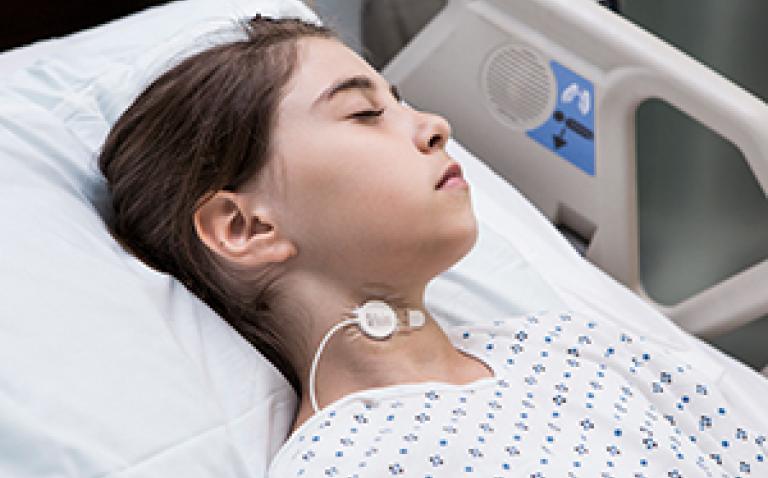Masimo has announced the full market release of RAS-45, an adhesive adult and paediatric acoustic respiration sensor for rainbow Acoustic Monitoring® (RAM™). RAS-45 offers the same performance as the currently available RAS-125c sensor but in a smaller size, with more flexible adhesive.
RAM non-invasively and continuously measures respiration rate using an innovative adhesive sensor with an integrated acoustic transducer, such as Masimo’s RAS-125c and now RAS-45, that is applied to the patient’s neck area. Using acoustic signal processing that leverages Masimo Signal Extraction Technology (SET®), the respiratory signal is separated and processed to display continuous respiration rate (RRa®) and respiratory waveform, with the option to listen to the sound of breathing from the acoustic sensor.
RRa has been shown to be accurate1,2, easy-to-use1, easy-to-tolerate,1,3 and reliable,1 and has also been shown to enhance patient compliance with respiration monitoring. In a study comparing paediatric patient tolerance of sidestream capnography with a nasal cannula to respiration rate monitoring with an RAS-125c acoustic sensor, 15 out of 40 patients removed the cannula, while only one removed the acoustic sensor.3 In a study of 98 patients consciously sedated during upper gastrointestinal endoscopy, researchers found that RRa monitoring with the RAS-125c sensor more accurately assessed respiration rate than capnography using end-tidal carbon dioxide (EtCO2) measurement or impedance pneumography.2
With its smaller size, RAS-45 is well suited for monitoring paediatric patients and patients with shorter necks. The RAS-45 adhesive is transparent, lighter, and more flexible than the RAS-125c adhesive. Like RAS-125c, RAS-45 operates with Masimo MX technology boards to measure RRa, display the acoustic respiration wave form, and optionally allow clinicians to listen to the sound of breathing. Both sensors are for adult and paediatric patients who weigh more than 10kg.
Joe Kiani, Founder and CEO of Masimo, commented, “RAM harnesses the power of our breakthrough signal processing technology and applies it to a respiratory measurement derived from the sound of breathing. With the addition of the RAS-45 sensor, RRa is now a more convenient and comfortable measurement for clinicians and patients – especially children.”
Continuous monitoring of respiration rate can be helpful in cases such as sedation-based procedures and post-surgical patients receiving patient-controlled analgesia for pain management. The Anesthesia Patient Safety Foundation (APSF) and The Joint Commission recommend continuous oxygenation and ventilation (respiration) monitoring for all patients receiving opioid-based pain medications.4,5
References
1.Macknet MR et al. Accuracy and Tolerance of a Novel Bioacoustic Respiratory Sensor in Pediatric Patients. Anesthesiology. 2007;107:A84 (abstract).
2. Goudra BG et al. Comparison of Acoustic Respiration Rate, Impedance Pneumography and Capnometry Monitors for Respiration Rate Accuracy and Apnea Detection during GI Endoscopy Anesthesia. Open J Anesthesiol. 2013;3:74-79.
3. Patino M et al. Accuracy of Acoustic Respiration Rate Monitoring in Pediatric Patients. Paediatr Anaesth. 2013 Sep 3.
4. Stoelting, RK et al. APSF newsletter. 2011. www.apsf.org.
5. The Joint Commission Sentinel Event Alert. Issue 49, August 8, 2012. www.jointcomission.org.










